$20 Bonus + 25% OFF CLAIM OFFER
Place Your Order With Us Today And Go Stress-Free
Energy Waste And Workforce Concern Of Stochastic Inventory Routing In The UK Food Logistics Industry
The food logistics industry in the United Kingdom is grappling with a multifaceted challenge, primarily encapsulated within two critical spheres: There has to be concerns about the employee and team performance as well as the sustainability of the resources while working in a virtual environment.
The main problem that needs to be focused on is using technology in a way beneficial for enhancing effectiveness with substantial limitations at hand. The wastage of energy becomes a major problem because there is always an uncertainty about the demand patterns.
This indeed is a reality, with the businesses shifting surmounting towards advanced systems to combat problems, and analyse better data; hence there needs to be a newer approach that will foster their initiatives of practical productivity. There would be an extensive study to enlighten us on tough matters of food pathway, showing new ways for improvements.
The food supplying system cannot be the best because there is a big issue of wastage of energy. The high amount of variance, as well as changing demand for products between buyers in the food industry, is a contributor to wasteful energy use within logistic operations.
The traditional method to route systems will lead to a lower amount of utilization of energy because they are not good at handling patterns and shifts in demand. This may cause extra fuel intake and carbon emissions if the vehicles are moved with less-than-optimized fuel requirements. The research tries to examine literature for energy-efficient routing systems, to display how they can be used in real-life situations.
Empirical data collection allows a detailed understanding of patterns related to energy utilization by the UK food industry. This data-based method allows scientists to recognize points of congestion and inactivity; therefore, making way for new creative solutions. The study also focuses on human resources and their capability to deal with changes. This highlights the significance of skill enhancement programs.
The importance of an experienced workforce that can combat logistical challenges is a must for efficient operations. It is important for industry stakeholders, educational institutions and government bodies to come together in order to meet the current needs of industries.
When it comes to the UK, there is an enormous issue of workforce adaptability and resources wastage (electricity/gas) within the food industry. The study will collect data and review relevant materials in order to improve the system. In order to provide the UK efficient, reliable and sustainable there are two things the study aims for: one is harness technological innovation and secondly develop their workforce by keeping in mind human values.
In the context of the UK food logistics enterprise, the integration of stochastic inventory routing has flashed both intrigue and consideration due to its potential effect on operating efficiency and workforce dynamics. Stochastic inventory routing concerns optimizing delivery ways amidst indefinite or variable market strategies (Abideen et al., 2021).
This procedure seeks to streamline inventory management and transport logistics, promising price decreases and enhanced resource distribution. However, notable problems have emerged in this creative process. Energy waste stands out as a preliminary matter, attributed to possible inefficiencies in routing and vehicle utilization stemming from fluctuating markets.

Figure 1: Study of the allocation of food imports from the European Union through the Short Strait (Source: Department for Environment Food & Rural Affairs, 2021)
The graph shows the volume analysis and proportionate shares of food imports from the EU in 2018. The UK laboriously turns on the Short Strait for specific food types, notably: fruits and vegetables accounting for 62% of EU imports in this class, meats 43%, and dairy products 41% (Department for Environment Food & Rural Affairs, 2021). Among all EU food commodities arriving through the Short Strait, about 44% consist of fruits and vegetables, 19% include drinks, 9% are meats, and 9% include dairy by-products.
The variability in order may lead to suboptimal routes, causing inflated fuel consumption and environmental importance. Together, workforce concerns continue, primarily about the adaptability and job security of workers in an environment where automation and state-of-the-art technology play pivotal functions.
Managing these concerns necessitates a delicate equilibrium between technical progress and workforce growth (Joshi et al., 2023). Measures to mitigate energy waste require refined route optimization software and systems to improve vehicle efficiency.
Simultaneously, authorising the workforce through training and upskilling endeavours becomes critical to provide seamless adaptation to the evolving landscape of logistics technology while protecting job resilience.
The performance of stochastic inventory routing in the UK food logistics sector offers a multifaceted challenge encapsulated in both energy waste and workforce adaptation problems. The primary difficulty lies in negotiating the promise of efficiency enhancement with the functional importance of pending demand systems.
Energy waste occurs as a crucial issue due to the intrinsic unpredictability in demand designs. Stochastic commodities routing, while developed to optimize delivery passages, presents a varying element that could lead to suboptimal transport paths. Therefore, this variability might trigger raised fuel consumption and operating inefficiencies, worsening environmental effects and operating expenses within the logistics chain.
Simultaneously, workforce dynamics appear as a considerable concern (Kaviyani-Charati et al., 2022). The integration of cutting-edge technical solutions for stochastic inventory routing may disrupt conventional functions within the logistics sector.
Workers face the challenge of adjusting to these technical advancements, potentially increasing fears of job insecurity and the demand for a change in skill sets. The problem statement circles around the market to strike a balance between leveraging technical invention for operating efficiency and managing the significant challenges.
It needs to devise techniques that minimize energy waste by optimizing path planning and vehicle utilization amidst unexpected demand changes. Simultaneously, providing a smooth transition for the workforce through training and up skilling endeavours becomes crucial to alleviate problems surrounding job security and skill applicability in a tech-driven logistics landscape (Khan et al., 2021).
Effectively managing this situation entails comprehensive standards that not only optimize logistical processes but also enable a workforce prepared to navigate the evolving technical terrain, thereby forming a symbiotic association between invention and workforce resilience in the UK food logistics enterprise.
The rationale behind performing research on the integration of stochastic inventory routing in the UK food logistics industry derives from the urgent need to manage existing challenges while maximizing the possible uses of this innovative system. Especially, the unexpected nature of direction in the food logistics sector necessitates a thorough knowledge of how stochastic inventory routing could optimize processes.
The research seeks to delve into the complexities of this procedure to minimize energy waste and operating inefficiencies generated by fluctuating market practices (Liu et al., 2022). By investigating this part, the research attempts to offer an understanding of mitigating environmental influence and reducing operating expenditures associated with fuel consumption and inadequate transportation ways. Similarly, the workforce problems with technological transformation and job safety are pivotal.
The research aims to investigate methods that enable a smooth change for workers, concentrating on training and up skilling endeavours. Comprehending the workforce's importance of incorporating stochastic inventory routing is important to provide a balanced system that harnesses technology for efficiency improvements while preserving workforce resilience and job relevancy (Mirabelli and Solina, 2022).
Further, the research motivation lies in the possible transformative effect on the enterprise. If successful, the integration of stochastic commodities routing could revolutionize how food logistics processes are controlled, optimizing resource distribution, and improving overall supply chain efficiency. This research seeks to deliver a roadmap for enterprise stakeholders to guide this modification effectively.
The immediate aim of this dissertation is to perform a thorough exploration of the intricate relationships among distinct elements pertaining to energy usage and workforce limitations within the framework of stochastic inventory routing within the UK's food logistics sector.
● To examine the challenges related to the workforce in operating stochastic inventory routing within the domain of food logistics.
● To study the correlation between energy wastage and inefficiencies in routing inventory straightforward to food products.
● To assess the impact of demand unpredictability and various travel times on energy consumption within the food logistics field.
● To develop and present designs alongside optimization strategies aimed at curtailing energy wastage while together managing workforce apprehensions regarding stochastic inventory routing in food logistics
RQ1: What techniques and optimization methods can be used to reduce energy use and tackle workforce-related barriers in stochastic inventory routing within the food logistics enterprise?
RQ2: How do variability in order and travel durations influence energy inefficiencies and wastage in routing food product commodities, and what possible remedies exist to relieve these effects?
Research Hypotheses:
1. Objective 1: To examine the challenges related to the workforce in operating stochastic inventory routing within the domain of food logistics.
• H0 (Null Hypothesis): There is no significant relationship between the implementation of stochastic inventory routing and workforce challenges in the UK food logistics sector.
• H1 (Alternative Hypothesis): The implementation of stochastic inventory routing is significantly associated with increased workforce challenges in the UK food logistics sector.
2. Objective 2: To study the correlation between energy wastage and inefficiencies in routing inventory straightforward to food products.
• H0: There is no significant correlation between energy wastage and inefficiencies in routing inventory straightforward to food products in the context of stochastic inventory routing.
• H1: There is a significant positive correlation between energy wastage and inefficiencies in routing inventory straightforward to food products in the context of stochastic inventory routing.
3. Objective 3: To assess the impact of demand unpredictability and various travel times on energy consumption within the food logistics field.
• H0: Demand unpredictability and various travel times do not significantly impact energy consumption in the food logistics field under stochastic inventory routing.
• H1: Demand unpredictability and various travel times significantly impact energy consumption in the food logistics field under stochastic inventory routing.
4. Objective 4: To develop and present designs alongside optimization strategies aimed at curtailing energy wastage while together managing workforce apprehensions regarding stochastic inventory routing in food logistics.
• H0: Optimization strategies do not have a significant effect on reducing energy wastage and managing workforce apprehensions in stochastic inventory routing within food logistics.
• H1: Optimization strategies significantly contribute to reducing energy wastage and managing workforce apprehensions in stochastic inventory routing within food logistics.
5. Overall Hypothesis: The implementation of stochastic inventory routing will lead to improved efficiency and sustainability in the UK food logistics sector.
• H0: There is no significant improvement in efficiency and sustainability with the implementation of stochastic inventory routing in the UK food logistics sector.
• H1: The implementation of stochastic inventory routing significantly improves efficiency and sustainability in the UK food logistics sector.
The importance of this study lies in its possibility to address pressing challenges and optimize operating efficiency within the UK food logistics sector.
By exploring the interplay between energy consumption, workforce dynamics, and stochastic commodities routing, this analysis aims to deliver practical explanations with far-reaching importance.
Interpretation and mitigating workforce-related challenges associated with executing stochastic inventory routing are pivotal for the industry's sustainability (Rabbani et al., 2020).
This study attempts to shed light on these challenges, enabling the evolution of systems that provide a smooth transition for workers while leveraging technology for improved efficiency. Additionally, the effect of stochasticity in order and travel times on energy waste within the food logistics enterprise is a pressing problem.
By discovering the correlation between these variables and energy inefficiencies in commodities routing, this analysis aims to offer feasible resolutions. Executing these solutions could greatly lower operating costs, minimize environmental effects, and streamline logistics processes.
Eventually, the importance of this research exceeds academic limitations, offering actionable understandings to industry stakeholders. It carries the promise of reshaping logistical procedures, optimizing resource distribution, and promoting sustainable processes within the UK food logistics enterprise.
This study delineates its scope within the confines of the UK's food logistics sector, concentrating on the nuanced dynamics of stochastic inventory routing and its importance. It contains a multifaceted investigation of energy consumption, workforce challenges, and the complex interplay between them in the context of optimizing commodities routing systems.
Within this scope, the research seeks to delve into the complexities of workforce-related problems triggered by the performance of stochastic inventory routing techniques (Singh et al., 2020). It contains an examination of the workforce's adaptability, possible skill gaps, and problems regarding job safety due to technical advances in logistics processes. Simultaneously, the study scrutinizes the effect of stochasticity in demand designs and various travel times on energy consumption within food logistics.
It seeks to examine how conflicted needs and fluctuating travel durations influence energy inefficiencies in routing food inventory. Further, the examination aims to identify possible methods and optimization strategies to mitigate these impacts, providing more efficient and sustainable logistics processes.
The research process applies a comprehensive study of existing literature, empirical data collection, and potentially, simulations or modelling to assess the real-world importance of different commodities routing systems (Vilas-Boas, Rodrigues and Alberti, 2022). The scope also considers offering feasible resolutions and procedures that strike a balance between optimizing energy use and managing workforce problems in the stochastic inventory routing landscape of the UK food logistics initiative.
| Section | Description |
| 1. Introduction | Background, problem statement, goals, and importance |
| 2. Literature Review | Examination of existing studies on stochastic inventory routing, energy consumption, and workforce challenges in food logistics |
| 3. Methodology | Research process, data collection, and analysis techniques |
| 4. Analysis and Findings | Study of workforce-related restrictions in stochastic commodities routing within food logistics |
| 5. Discussion | Research into energy waste and inefficiencies in inventory routing |
| 6. Conclusion and Recommendations | Overview of findings, implications, and actionable suggestions |
The intersection of workforce concern and energy waste stochastic inventory routing in the UK involves various discussions. It has mentioned various challenges which are related to energy waste and workforce concerns in the food industry. It mentions the impact of unpredictability on demand and consumption of food logistics.
Furthermore, it mentions the process of supply food chain management in the UK food industry. Moreover, that discusses the theoretical perspective and various literature gaps which are important to identifying the key factors of the project. It also mentions the environmental impact and generation of food waste in the UK.
Wastage of the food supply chain is one of the major issues that involve various stages of the production of waste consumption which creates issues in environmental damage. As per the analysis of Rabbinic et al, (2020) Food waste is generated in homes, public places, hospitals, industries, and many other places. Employees are collecting the food waste from the mentioned place.
Then after storing it in one place, it drops in a suitable place where waste is required to have less impact on the environment as well as human health. As per concern by Kaviyani-Charati et al, (2022), the various processes are mentioned such as production, harvesting, manufacturing, distribution and logistics. It also is effective such as supply chain monitoring, collaboration and worker involvement.
Collaboration of employees on food waste clearance is also an important process. The country is divided into various cities and various places to clean the waste food material. As per the suggestion by Liu et al, (2022), Food waste clearance departments provide employees to store food waste from all homes, industries, institutes, hospitals and other various public places.
Collect food wastage at each phase of the supply chain to determine areas of wastage and inefficiency. Food waste generally but not just happen at the retail and consumer levels whereas nutrition loss takes place at the earlier stages of the food supply chain – during production, post-harvest and processing stages. This contains exhibition, processing, issuance, retail, and consumer levels.
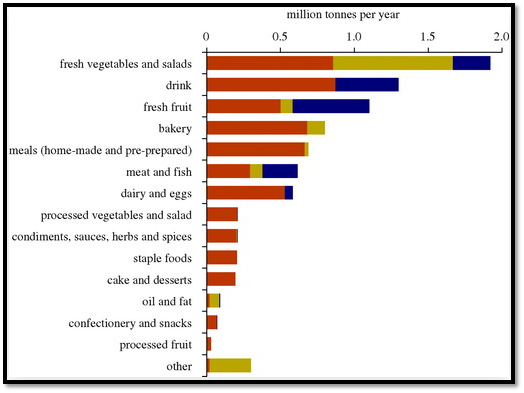
Figure 2.1: represent the various food items that are involved more in food wastage
(Source: Singh et al. 2021)
Graphs represent the various food items that involve more food wastage in different years. Fresh vegetables and salad are generating more food wastage. It has 2.0 tons per year so it needs to be reduced. Various drinks also generate more food wastage which is 1.5 times per year.
Further, the graph represents the wastage of meat and egg products involving 0.5 tons per year wastage. As per the analysis of Singh et al. (2021), Workers are gathering food waste from the mentioned place.
Then after storing it in one place, it drops in a proper place where waste is required to have less impact on the environment as well and human health dairy products are also involved in food wastage which is .07 tons per year.
Condiment sauce and spice are also inversing the generation of food wastage in the UK. Processed fruits involve a little bit of wastage in the UK environment, generating less than 0.1 tons per year
2.3 Correlation between energy wastage and inefficiencies in routing inventory straightforward to food products.
Comprehending the workforce's importance of incorporating stochastic inventory routing is important to provide a balanced system that harnesses technology for efficiency improvements while preserving workforce resilience and job relevancy. As per the analysis of David et al. (2022), further, the research motivation lies in the possible transformative effect on the enterprise. If successful, the integration of stochastic commodities routing could revolutionize how food logistics processes are controlled, optimizing resource distribution, and improving overall supply chain efficiency.
As per the cited by Vilas-Boas et al. (2023), there are various corrections between the energy wastage and inefficiencies in routing inventory straight forward in food production like sub optional route planning, traffic conjunction, route change deviation, environmental impact, technology integration and operational cost.
The main causes of food loss have roots in management problems, such as inadequate demand forecasting, maintenance cost, employee behaviour, overproduction, public behaviour and inadequate inventory management. technical inefficiencies, like inadequate packaging, improper handling in public places, and storage, bad habits of people, and poor processing operations,
It impact more sudden changes in the workload of employees so they do not maintain proper balance in the food industry. As per the analysis by Jazinaninejad et al. (2022), Driver skills and training are major factors in raising food waste in the UK environment because they are not cleaning the city promptly and not maintaining the schedule of cleanliness even wrong labelling management issues, such as inadequate demand forecasting, functional cost, overproduction and inadequate inventory management.
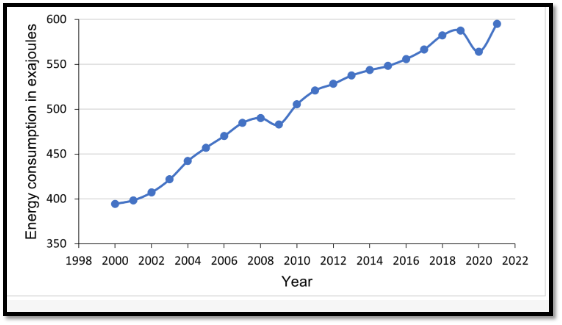
Figure 2.2: Energy consumption worldwide from the year 1998 to 2022
(Source: Statista.com, 2021)
The graph represents the energy consumption worldwide from 1998 to 2022. It has shown that in the initial period, the energy consumption is because of less population, less demand and fewer facilities. In today's time demand is increasing day by day, population is increasing rapidly so energy consumption is increasing. As per the cited by statista.com (2021), energy consumption shoes in terms of joules.
In 1998 it consumed 400 joules and in 2008 it reached 495 joules. It shows that energy consumption is increasing year by year. More of that in the year 2010 it reached 500 amour energy consumption and in the year 2016 it reached 550 joules energy in the year 2018 it reached 600 joules impacting more in up food waste industry
Challenges that are faced in the food industry in the UK such as Dynamic Scheduling and Unpredictable Workloads, Driver Skill and Training Requirements, Communication and Coordination, Employee Satisfaction and Retention, Technological Integration and Adaptation and work-life balance.
As cited by Mirabella et al. (2022), Dynamic Scheduling and Unpredictable Workloads are some of the major reasons that are creating more issues with workforce function in stochastic inventory. There are issues in workforce scheduling that destroy the variability and change delivery requirements. As per concern by Rae and Aoudad, (2022).
It impacts more on sudden changes in the workload of employees so they do not maintain proper balance in the food industry. Driver skills and training are major factors in raising food waste in the UK environment because they are not cleaning the city promptly and not maintaining the schedule of cleanliness. So waste is kept in the garbage for the long term that smells like a belly and it smells like dangerous gas that directly impacts human health which varies dangerously.
Communication and Coordination are very important in the food waste industry and it helps to keep the city clean. As per suggestion by Kumar and Agawam, (2023), however, there are many ways to make good communication and coordination such as creating storage of waste material where employees can store the waste and then drop the bulk amount of waste in suitable areas.
Take an inventory where people have easy to store their food waste in their small garbage and c communicate with the municipal employees to bring their waste which is beneficial to the local environment.
As per concern Lack of awareness on maintaining the food waste that creates major disadvantages in the UK environment so it needs to be improved. Asking them to inform the employees to bring their food waste from their homes There are many different dangerous gases in the food waste that impact climate change so they need to be aware of the cleaning of food wastage.
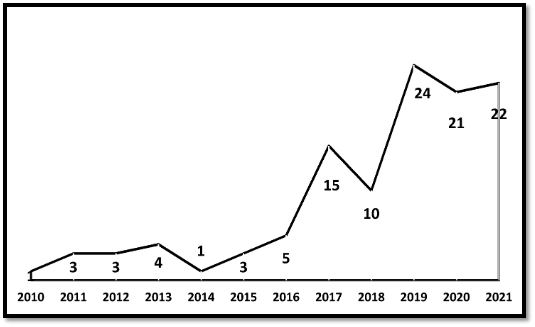
Figure 2.3: Represents the impact of challenges in workforce concern in the food wastage environment from the year 2010 to 2021
(Source: Fidel, 2021)
The above graph represents the impact of challenges in workforce concern in the food wastage environment from 2010 to 2021. In 2010 mining challenges were faced by the food industry because of various reasons such as low population, use of bags and plastic.
However, in the year 2011, it has slightly increased similarly in 2012 and 2013. As per suggestion by Fidel, (2021), suddenly it has decreased the challenge in 2014 because of various reasons such as more number of municipal employees being hired which provide the best service to clean food waste.
Moreover, it has raised the economy Betsey the government does not provide their salary and précis, so employees are not delivering their best service which is sincere about the issue of food wastage. It has risen 15% in 2017 and 10% in 2018.
As per the cited by Joshi et al. (2023), the government is not hiring more employees and even not giving the present employees a salary so it directly impacts the workforce in the food wastage sector.
In 2019 it will rise to 24% and in 2021 it will rise to 22% in the workforce in the food wastage sector, Employee Satisfaction and Retention. Technological Integration and Adaptation and work-life balance are also the more challenging food wastage industries in the UK.
The analysis of The impact of demand unpredictability and various travel times on energy consumption within the food logistics field is more significant in the food wastage industry.
Travel time is one of the major parts because if consuming more travel time then wastage is stored more in and creates issues on shedding off the employee's workforce. As per suggestion by Kumar and Shankar, (2022), Here's how demand unpredictability and various travel times can affect energy consumption such as Increased Energy
Consumption due to Inefficient Routing, Idle Time and Vehicle Turnaround Braking and Acceleration Patterns Environmental Impact: and technology adaptation.
There are issues in workforce scheduling that destroy the variability and change delivery requirements. As per concern by Handan et al. (2023), it impacts more on sudden changes in the workload of employees so they do not maintain proper balance in the food industry.
Travel time is also consuming more energy in the food logistics field. Demand unpredictability increases wastage because employees cannot predict how much wastage is generated and how it can be cleaned quickly.
Demand unpredictability leads to the sub-national routing decision and long mechanics are needed to remove the food waste property because it can store more waste in a single time. As per concern by Mangle et al. (2021), the difficulty lies in negotiating the promise of efficiency enhancement with the functional importance of pending demand systems. Energy waste occurs as a crucial issue due to the intrinsic unpredictability in demand designs.
Stochastic commodities routing, while developed to optimize delivery passages, presents a varying element that could lead to suboptimal transport paths Increased Energy Consumption due to Inefficient Routing are facing major challenges. As per the cited by Latina,(2023).
Due to insufficient routing, it has increased consumption of petrol diesel, work time of employees and cost. So the food waste industry needs to maintain the travel routing and maintain their cost.
Increased travel time directly impacts the UK environment because more dangerous gas, bacteria and other insects are generated from food wastage which is dangerous for human health Moreover the consumption of energy more so cost should be inverse rapidly.

Figure 2.4: Final transportation energy demand
(Source: Serb, 2023)
The above graph shows the final transportation energy demand on various factors which are represented in different colours. As per the cited by Serb, (2023) Blue colour represents food waste transport through the road, orange colour represents road passengers, yellow colour represents rail transportation, and green colour represents aviation passengers.
The major secret to transport food wastage is to road passengers. Many of the food waste will be transported by road in 2020. It should be mentioned in the future perspective that in 2030 it should also be the maximum.
Rail facilities are also available for transporting food waste in the UK. As per suggestion by Tripathi et al. (2021), mentions the impact of unpredictability on demand and consumption of food logistics. Furthermore, it mentions the process of supply food chain management in the UK food industry. It is very effective because it requires fewer employees and gives more effective work in the food wastage sector.
Greenhouse gases are generated largest in the UK, largest from the US and China due to the wastage of more food so it impacts more in UK environment condition. As per the analysis of Gladys et al. (2020), Food wastage from various sectors is directionally related to the environmental condition.
The major part is vegetable food items that create more waste. Energy waste occurs as a crucial issue due to the intrinsic unpredictability in demand designs. As per concern by Rivera et al. (2023) Hotels and institutions waste food material more which should affect more environmental conditions.
Stochastic commodities routing, while developed to optimize delivery passages, presents a varying element that could lead to suboptimal transport.
As per the suggestion by Ferraro et al. (2022), Take an inventory where people can easy to store their food waste in their small garbage and c communicate with the municipal employees to bring their waste which is beneficial to the local environment. Lack of awareness on maintaining the food waste creates major disadvantages in the UK environment.
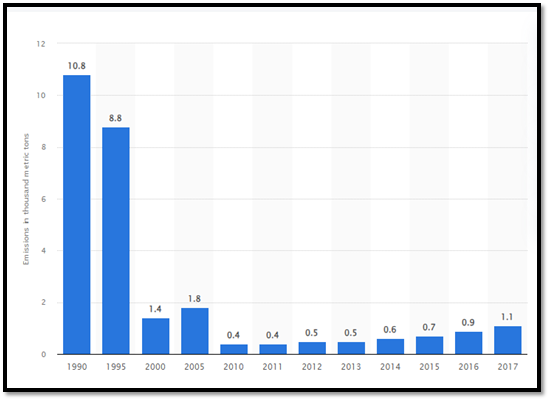
Figure 2.5: Sculpture dioxide (SO2) emissions from waste collection, treatment and disposal services in the United Kingdom (UK) from 1990 to 2017
(Source: Statista.com, 2023)
Graph representing Sculpture dioxide (SO2) emissions from waste collection, treatment and disposal services in the United Kingdom (UK) from 1990 to 2017. Sculpture dioxide is generated more from food wastage which creates major issues in the local environment. The main theme of the graph is to mention the effect of sculpture dioxide emission in the UK environment. As per suggestion In 1990, it emitted the highest 10.8 thousand metric tons.
It happened because of a lack of technology for the disposal of food wastage. Furthermore, in 1995 it emitted 8.8 metric tons of sculpture dioxide gas that impacts more on the environmental condition. As per the cited by Hans et al. (2023), Day by day it is destining because adaptation of new technology in 2005 it comes to 1.8 metric ton emission generation.
Now the next four to five dates are going similarly and in 2016 it generated 0.9 metric tons of sculpture dioxide. Finally, as per the graph information in 2017, it generated 1.1 metric tons of sculpture dioxide. It has less than the initial period because nowadays new technology is adopted in the food waste industry for cleaning the waste from the environment.
The complexity of stochastic modeling is one of the important parts of the food wastage industry which is not mentioned in the study. As per concern by Taghikhah, et al. (2019), In the Complexity of stochastic modeling, routing involves complex mathematical models that relate to real-time decision-making. Furthermore, the study has limitations on the planet of the people who are wasting more food and are not concerned about the safety and cleanliness of the environment.
As per the cited by Godden, et al. (2021), the gap in land acquisition for the disposal of waste material impacts directly to the environmental condition. It generates more greenhouse gases. The dynamic nature of the food wastage industry system also does not provide a special schedule for their employees to collect the waste material.
Behavior theory reflects the consumer behavior of consuming more food and enhancing less waste of energy that impact well in the food system sector. As per the suggestion by Leady et al. (2022), This theory should also be studied on people making decisions on how much they can supply and buy food items in the UK market.
Innovative working strategy and principal management process to improve strategic service developmental aspects constructively developed a sustainable scope in the service management process.
As cited by Sharma et al. (2021), innovative working principles and approaches are incorporated into strategic service developmental processes to help in improving constructive management structure, application of technology-based service strategy in pollution analysis and managerial processes strategically involved in the comparative improvement and developmental structure.
Management theory is more reflected in the food logistic industry gives a proper platform to supply food in every place. As per the analysis of Bausch et al. (2021), Manaement Theory is beneficial for coordinating, commanding, controlling and supervising logistic activities. Management theory is also beneficial for the employees who are providing their service in the food supply sector that saves food waste in the UK market.
It impacts more on sudden changes in the workload of employees so they do not maintain proper balance in the food industry. Travel time is also consuming more energy in the food logistics field. As per suggestion by Singh et al. (2022), Management theory reflects on giving more benefits to the food logistic industry by decreasing food waste and increasing energy generation.
Technology can also be impacted more by management theory because technology can supply more items in a very short time and it maintains all data properly.

Figure 2.6: Conceptual framework
(Source: self-created)
Summarized, on study the of energy waste workforce concern the stochastic inventory routing in the UK food logistics industry. It mentions the impact of unpredictability on demand and consumption of food logistics. Furthermore, it mentions the process of supply food chain management in the UK food industry.
Travel time is one of the major parts because if consuming more travel time then wastage is stored more in and creates issues on shedding off the employee's workforce. Challenges that are faced in the food industry in the UK such as Dynamic Scheduling and Unpredictable Workloads, Driver Skill and Training Requirements, Communication and Coordination. Moreover, that discusses the theoretical perspective and various literature gaps which are important to identifying the key factors of the project.
The methodology applied in this chapter is designed to elucidate the intricate dynamics between energy waste and workforce issues within stochastic inventory routing in British food logistics. Applying a mixed-methods approach, the study seeks to provide comprehensive insights into research objectives by analyzing both quantitative data and qualitative perceptions.
The research design is characterized by purposeful sampling covering varied logistics firms and the data collection procedure incorporates historical logistics information as well as employee surveys.
Quantitative analysis applies statistical approaches and optimization models to discern patterns of energy dissipation; qualitative analysis, accomplished through theme identification following survey responses, examines human aspects relating workforce concerns.
The framework for data treatment is based on ethical principles that structure the research process. This methodology provides a strong foundation for studying difficulties faced by the sector, thus adding great value to scholars and practitioners with regard sustainable logistics practices. Chapters following this will present results based on the use of such a methodology.

Onions’ study methodology applies a systematic process of onion growth, quality, and post-harvest handling. On the other hand, field experiments with different onion varieties using various soil types and irrigation methods among several climate conditions are included in research design.
Data gathering comprises the evaluation of growth parameters, quality characteristics as well wherein environmental factors are monitored. Further, laboratory analyses are performed to determine nutritional quality and disease resilience. Storage experiments and transportation simulations are used to study post-harvest handling techniques.
The proposed holistic methodology seeks to analyze the effective measures of enhancing onion production, along with preserving quality from farm-to-market and taking into account critical issues in agribusinesses.
Conducting philosophical onion studies implies a specific methodological approach that covers ontologies, epistemology and the ethics of knowledge about an onion’s existence. Ontologically, this study views onions in terms of their ontology: what they are and how you can measure existence as an agricultural subject.
From an epistemological point of view, it addresses the means by which knowledge about onions is attained considering that our culture, history and science influence how gain understanding.
From an axiological perspective, the study assesses onion values and their implications in different food recipes, medicinal use as well cultural practices.
This philosophical methodology is intended to give deeper meanings and implications of onions leaving out only matter-of-fact attributes, providing grounds for a wider conversation concerning the true nature of agricultural specimens in relation to human perception and its impact.
The foundation of the Choices methodology lies in a multifaceted approach that incorporates cognitive, emotional and contextual factors impacting decision-making processes. Starting with an analysis of individual preferences and cognitive biases, the research entails questioning responses to different situations in order to identify patterns and behavioral trends.
Qualitative interviews and psychological tests are used to consider emotional dynamics, revealing the affective mechanisms that influence the decision outcomes.
In contextual analysis, environmental factors that affect choices are studied to provide a complete understanding of decision-making. This approach aims to untangle the knot of factors that form the basis of human decision-making and provide broadly applicable knowledge for psychology, economics, and marketing.
The temporal dimensions of the Time Horizons methodology are also explored in considerable depth and systematically throughout a number of contexts. It encompasses analysis of short term, medium term and long-term views to understand how time loops bring change in various scenarios.
This methodology, working through historical analysis of trend forecasting and scenario planning attempts to uncover patterns in the future, trends and different timelines.
Adopting a view that looks to the future, this analysis aims at providing practical suggestions helpful for strategic management, estate planning in finance and policy-making.
As such, this integrated view of time horizons provides a complex image on how issues concerning temporal aspects dictate the results and approach in various spheres.
The Techniques and Procedures methodology is the scientifically based procedure which involves collecting, analysing data in accordance to research. It encompasses selecting and implementing specialized techniques depending on the research objectives. In this approach, research questions and goals are initially defined, followed by the selection of appropriate data collection tools.
Researchers choose the right methods that include surveys, experiments interviews or case studies such as their study type. After that, rigorous procedures are designed for data processing and interpretation to achieve validated and decisive results.
This method provides a systematic and replicable model for carrying out different types of research in various branches of science that ensures the accuracy to achieve useful output.
How to handle inventory in the UK’s food industry was researched using a quantitative approach. This approach helps us to systematically obtain quantified measurements, from which can make interpretations regarding the behavioural relationships among various factors in that given ecosystem.
To ensure effective food distribution, complete analysis of problems should be made. This can be achieved through the selection of quantitative research methods.
Quantitative research concerns itself with quantifiable findings and pays attention to measurable outcomes. This approach is practical since it helps us create a solid and conspicuous pathway of addressing the inventory issues that are linked to multiple factors. In research, it provides a clear linkage on the relationship between variables and is essential to make valid conclusions.
As the most appropriate research design, this current study will analyse how energy consumption relates to workforce functions in random commodities within a context. Confirm patterns and trends through quantitative methods using rooted statistics on the data set to determine correlations present in identifying such pattern. The statistical inferences lead to conclusive insights which confirm the empirical basis on which can move further.
Normally, a better plan and consistent data supply are needed for the UK food industry to run. This can only be achieved by a quantitative research system. This method, therefore allows us to better conceive the presented insights through a smart way that helps us simplify and comprehend foodstuffs.
The data is primarily collected through surveys. These surveys are conducted among the stakeholders of the UK logistics industry. Surveys are found to be an efficient way because it helps in gathering a large amount of data and to understand workflow concerns.
Data needs to be collected for various dimensions of the research work such as there should be something to quantify about how well people are handling change and what gaps exist in enhancing their abilities, which specific parts of the job they worry may not exist tomorrow, (this is especially relevant with an increasing automation), and any inefficiency signals on how certain commodities are routed.
The survey questions are made after reading the existing literature, which will pave the path for relevant queries to be asked on it. The questions are designed in a way that can allow us to collect responses through which can perform statistical analyses. Besides this Google form has given a user-friendly interface for the respondents, which allows for more people to participate and greater accurate data.
The most important method to collect data is by creating a survey, and the instrument chosen for this purpose is Google Forms. The form is designed in a way to capture and understand tangible replies. It includes rating based questions, and some close-ended ones.
Closed-ended questions can be used to make a statistical analysis of the responses, providing less room for lucid interaction. On the other hand, Liker scale-based statements value giving such detailed overview as to how participants agree or disagree with specific notions presented within the survey.
To structure the data in a good manner, save it securely and gather it automatically, Google forms are important. Our survey allows researchers to incorporate features such as branching and skip logic which ensures that each participant is shown questions based on their roles and domains.
For the conduction of data on workforce concerned and energy consumption patterns, there will be an online survey through Google forms for a quantities research design. The way researchers are planning on their work is by assuming them hypothesis, following deductive methodology from already established theories and lastly comparing the data.
This study follows a deductive approach where it will test the hypotheses derived from existing theories and literature. For better routing of the inventory, efficient consumption of energy and concerns about the workforce should be addressed through deductive approaches. An efficient way to study the relationship between different variables within the UK food industry is by first hypothesizing through theoretical ideas.
Deductive methodology will provide a structured course for the theory and make it easier for students to explore different patterns, allowing them to see the correlations between them. Through this study, hypothesize that there is going to be a significant impact of the inventory routing system on the energy consumption levels and workforce adaptability.
The type of research is cross-sectional and it's related to the food industry within the UK. A cross-sectional study is important because it will provide an insight into the immediate needs of the industry. Through this workforce can determine their way of using energy and the number of products present at a particular time to deliver.
Through the research a comparison is to be drawn among components so as to extract differential behaviors elicited by different groupings and classifications. This comparative study will take differences between various stakeholders like the logistics companies, regulatory authorities and transporters. This will help to increase the depth of study. This will help in understating the problem more comprehensively and thoroughly because it enables us to see variations within different industries.
The sampling strategy opted is well designed to ensure a comprehensive representation of different stochastic inventory routing roles within the UK food logistics industry. A multifaceted approach is to be adopted, to address the challenges of this sector which include regulatory authorities, transport operators etc and there is a need for important insights from these stakeholders.
It is very important to prioritize when choosing the individuals based on diversity. Studies can capture huge experiences, views of random inventory route problems through it. The research aims to bring together a diversified set of individuals from different roles within the industry.
The regulatory authorities provide important compliance challenges and policy insights. Having the diversification will be a key point in establishing a solid ground for the inventory to reach between vendors.
To have a good representation within the commonly occurring subgroups, stratified sampling is the best technique to employ. The participants are divided into different groups according to their role in the company Stratification is important for selecting participants, since it ensures that every subgroup has the right representation according to the size of each stratum.
This technique makes it easy to read and understand complex information quickly. It also provides a good way for the student to compare industry segments within themselves. Through performing individual analysis of these subgroups, very peculiar informative data can be extracted which is specific to each role within the logistics sector.
Selecting the right sample size is an important part of sampling. The decisions are made based on the diversity of the industry and meaningful results to be drawn through it. A balance is needed between the increasing diversification of role and logistical stuff which takes place while collecting data. The sample size can be calculated, once know how confident want to be with the findings, and what level of precision is required for the study.
This research's goal is to map the system of challenges and perceptions within food logistics in the UK. It aims to do so by first selecting a representative sample using stratified sampling, efficiently.
To quantify the data which is gathered from the google form a thorough systemized method will be employed. Various statistical tools and techniques will also be utilized to find out various patterns and relationships within that dataset, Descriptive statistics include means, standard deviations that provide a starting step for summarizing such key components. This summary emphasizes the main points that refer to workforce, possibly available resources and stochastic inventory routing.
Analysis of correlation among variables is a crucial step in determining how they are related to each other. This method is used to measure how the workforce views, energy usage models and the complications in stochastic inventory routing are all positively or negatively inter-related. This can be beneficial as it provides insights into how these factors interact and what the dependencies and connections are which will be helpful.
To have an insight into the predictive and causative relationships, regression analysis will be used. By incorporating stochastic inventory route, are able to assess the impact of independent variable on dependent variable in supply chain. When quantification of relationships takes place, can use regression analysis to get a comprehensive understanding of how changes in one variable impact the others.
There will also be analysis for subgroups to assess differences among people belonging from different job roles within the industry. This exam will help us know more about how some specific tasks impact different roles and departments. This approach provides an in-depth analysis that covers diverse perspectives and responsibilities within the industry.
All research involving human subjects are required to adhere to the highest standards of ethical conduct. In effect, this research stresses the significance of ethical standards in obtaining all participants’ consent. Before the gathering, all of those who will provide data are informed about what kind information is collected and how it’s utilized as well as for which aim. It should be made clear that individuals engage in research of their own accord and can discontinue participation at will without additional restrictions.
Data security should be the first thing to consider when designing a system. Confidentiality will be maintained, and participants’ data are confidential as their identities have been disguised. This ensures that confidentiality of participants is maintained in research outputs such as publications or analysis, there will be no data identifiers.
To guarantee the ethics of research quality and transparency, it is crucial that standards are followed through. There are guidelines that protect the rights of people study.
Given that the research will follow all ethical standards, integrity is always maintained throughout this work. This research will be conducted in order to preserve anonymity of respondents, give priority and closely adhere to ethic regulations for full transparency.
To make sure that the results of any research are believable, it is very important to guarantee that the study conducted was reliable and valid. The survey is made very carefully, keeping in mind the vast amount of existing knowledge in the field. The survey questions are efficiently developed to meet the research goals.
This is to make sure that by Homogeneous supply chain management can obtain through the UK food logistics industry, people, organizations effectively encompasses information at a high level. A small initial study will be done to ensure that the questionnaire is clear and effective, Piloting will provide an opportunity to make necessary adjustments after the identification of any ambiguities, making sure that the final version is error-free and easily understandable.
If the data collection process is standardized, it ensures consistency in its quality and that, in turn, increases reliability. The surveys are equally distributed among the participants leading to an unbiased large amount of data. The structured format of closed-ended questions and Likert scales make it possible to extract responses that are quantifiable and built on comparability, thus increasing the reliability of data. This format is more reliable because it brings down any ambiguities and provides a clear way to respond.
Also, when there are multiple researchers working on the data, the reliability of interpretations can be evaluated. This assessment is done so that to ensure the uniformity in the ideas and reliability amongst the researchers. The trustworthiness of the research is established by having analysts reach the same conclusion points through reliability checks.
This research will ensure that the outcomes are valid and reliable by making certain measures. For example, to refine efforts, there is thorough piloting that fits with a standardized procedure of embedding details in survey design among others. To ensure the reliability of the findings and conclusions of any study, there must be certain measures followed through in terms of food logistics in UK.
The research design is useful to find the complexities of stochastic inventory, but there are still drawbacks. In this study only get to see the static nature of things, so the changes over time cannot be reflected.
The data bias will be mitigated since it largely relies on self-reported survey approach. However, this may limit the generalizability of findings which will only root a specific context to UK food logistics industry.
Outside factors that are related to economic changes and technical improvements can change the results of what see in this study. Even though there are certain limits that the research faces, it aims to provide valuable recommendations that enhance inventory routing processes.
The food logistic industry needs to be optimized efficiently, which shows multiple statistical methods allowing a deeper understanding of the field. This study uses different models (Multilayer perceptron, T-Test, Regression), and Descriptive statistics to analyse the area. Statistical methods will be used to examine the interaction between different variables. This raising complicated questions so have a better understanding of what kind of possibilities and challenges.
The domain of logistics, specifically in the area of food distribution, is very complex because many things need to work together for efficient and sustainable operation. The student should understand the importance of the logistics in food distribution, which involves multiple factors and interactions.
The word "complex" convey the student's understanding of multiple elements in logistics, which greatly impact the system, and "efficient" and "sustainable" reflect the desired operation of the logistics.
The purpose of this survey is to understand the thoughts of professionals in the industry on significant issues like route optimization, methods to enhance fuel efficiency, dynamic demand, green logistics strategies, demand forecast accuracy, as well as the employment of tech in uncertain inventory routing. The dataset, which includes 110 participants' responses, contains a considerable amount of information. It is analysed using descriptive statistics.
The initial research tries to understand the relationship between ineffective route planning and fuel consumption focusing on the attitudes towards route planning among the students' group. As per the average values, which are calculated by adding the values from the 11th and 12th questions, the agreement level among the participants is considered moderate. The mean values suggest that everyone agrees that the ineffective route planning has a big impact on the fuel consumption. According to experts, optimizing transportation routes is important because it helps reduce excessive fuel usage.
The question examines the complexity of uncertain demand, its influence on the spoiling of food, and how it results from delays in supply or inefficient routing. Using a variety of responses allows for more comprehensive analysis. The average value of 2.55 and a little increased standard deviation demonstrate this.
Different replies indicate that there are many different perspectives on how the world works. Some people experienced food spoilage due to sudden spike in demand, but others did not face it as vigorously. The various styles of logistics show how intricate and multifaceted the logistics business is, demands adaptability in strategies to confront ambiguity.
The importance of green logistics strategies in decreasing energy consumption and minimising environmental effect is widely acknowledged. Question 15 examines the perceived significance of implementing these practices within the surveyed group. The average value of 1.60 indicates a modest level of consensus among participants, emphasising a collective acknowledgment of the importance of ecologically sustainable methods.
The presence of a standard deviation of 0.492 suggests that there is a notable degree of variety in opinions, which may be attributed to contrasting priorities or experiences. This discovery emphasises the significance of taking into account the many viewpoints within the sector when promoting sustainable practices.
The effectiveness of current demand forecasting methods is analyzed in questions 16 and 17. The impact of variations in travel time on the optimal routes is also studied in these questions. These questions are rated on a scale from 1 to 3. The rating indicates how much agreement or disagreement is expressed.
The participants considered the scores of 2.45 and 2.55 uncertain or potential for improvement. The standard deviations of 0.517 and 0.518 indicate a noticeable spread in opinions among the participants. Different people have different beliefs and priorities. While some have more trust in their systems, others focus more on the challenges that come with changes in travel time. Routine demand forecasting is a complex task that requires taking into account multiple opinions and the influence of external variables on the route's ability to function.
This information helps in understanding the industry's experts' perspective on important elements of food logistics. The questions 11 and 12 are saying that if do not plan routes properly then will use more fuel which will affect overall journey. However, Questions 13, 16, and 17 depict a diverse situation containing various encounters and standpoints.
It is evident that green logistics solutions are of utmost importance to all participants and collective efforts are being made to prioritize environmental sustainability in the supply chain. It is evident that the industry values innovation and is quickly adopting new technology due to its recognition of its significance.
This research presents an extensive analysis of the opinions and backgrounds of professionals in the field of food transportation. The research concludes that a lack of proper route planning affects fuel consumption and has a significant impact on the demand and duration of travel. Sustainable practices and technology adoption by the industry show how logistics is constantly evolving towards efficiency and environmental responsibility.
Table 1: Descriptive Statistics




Figure 2: Supermarket chain

Figure 3: Job Title

Figure 4: Year of experience in food logistics

Figure 5: Years of experience in food logistics
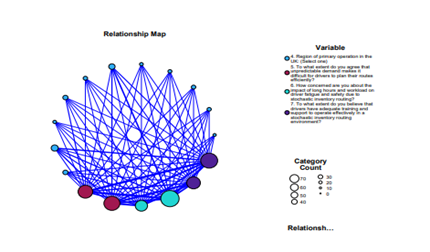
Figure 6: Relationship Map
The effective operation of food logistics business is highly dependent on optimizing logistics and transportation operations, especially in the field of stochastic inventory routing. This survey is aimed at collecting the opinions of business experts on the problems faced by truck drivers, with a particular focus on the challenges they encounter.
The table shows the results of the ANOVA analysis, which helps analyze the variation of responses between different factors like route planning, driver fatigue, training, communication systems, and satisfaction with work. This detailed analysis provides an in-depth examination of each topic, delving into the implications of the ANOVA results.
The first question asks if unexpected demand can make it difficult for drivers to plan their routes. The Between Groups Sum of Squares (2.300) represents the variation of responses among the groups, whereas the Within Groups Sum of Squares (10.230) assesses how differing replies are scattered within every group.
F-statistic is 0.530 which shows us the ratio of variances but it is important to note that the significance level isn't mentioned. The results suggest that there are differences in the responses, but the information given is not enough, so need a more detailed investigation orpost-hocanalysis to find out exactly what those differences are.
In Question 2, the outcomes of working extended hours and expending a lot of energy on drivers fatigue and transportation management. My findings were consistent with what was reported in Question 1. The Between Groups Sum of Squares was (2.245) and the Within Groups Sum of Squares was (23.718). Just like the first question, can't determine if the results are statistically significant because no significance level.
This question is about how the drivers feel about the training and help that they receive while studying the inventory routing situation. It seems that in this analysis of ANOVA, there is a total of 1.624 between group’s sum of squares and 25.430 within groups sum of squares. F-statistic is 0.632, so need to be very careful when interpreting the results because there is no significance threshold. The outcomes show a wide range of responses, which means need to do more research to know the reasons and significance of these differences.
When analysing satisfaction with communication systems in relation to real-time updates on delivery schedules, Question 4 shows a Between Groups Sum of Squares of 1.275 and a Within Groups Sum of Squares of 24.916. The F-statistic (0.507) indicates the ratio of variance between groups to variance within groups. However, the absence of the significance level makes it difficult to determine the statistical significance of the observed variations in satisfaction levels.
By incorporating the effect sizes (Eta-squared, Epsilon-squared, and Omega-squared) in different settings, it becomes feasible to comprehend how a drivers' years of experience shapes perceptions. There needs to be a more robust evaluation which takes into account the possibility of in homogeneity of variances despite offering equality of means through Welch statistics. The survey data shows that the effect of experience years is moderate and low. According to the fifth topic, when it comes to the unpredictability of demand.
Then Eta-squared is 0.084 and Omega squared is 0.108. These values show that the work experience has an impact on how drivers efficiently navigate through unpredictable customer demands on certain routes. Questions 6, 7, 8, and 9 all carry a similar weight from range of 0.060 to 0.086 showing the enhancements of ingredients in them don't vary largely.
The estimation performed to find the effect size of the population is relatively inaccurate because of the narrow confidence intervals. It should be noted that the lower bounds of confidence intervals are almost close to zero significant. Although the findings have some practical implications about the importance of experiences, there was no significant value found to support them.
This implies that they are not robust enough statistically. The strong testing process checks the equality of the mean by a robust scale that would show accurate differences found between groups and will prove it not quite insignificant. It comes to questions 5 through 9, the Welch statistics are as follows: 0.862, 0.588, 0.470 and 0.619. When the p-value is greater than 0.05, then it represents that data is insignificant because there are no chances of seeing a big difference.
There must be a considerable difference between group 1 and groups 2 for t-test to be performed. This emphasizes to focus on reliability of statistical results when analysing large datasets which usually tends to fluctuate among variance points. Effect size is an important indicator through which one can gauge the impact of experience among drives on inventory routing. It is important to consider of the statistical significance needs to be interpreted cautiously as it indicates that there might be other complexities
The question 5 is about the effect of the stochastic inventory routing on the job satisfaction of the driver's sector. The ANOVA results include a level of 0.699 that helps us understand the hypothesis test better. To figure out the F-statistic (0.725), need to add together the Between Groups Sum of Squares (1.814) and Within Groups Sum of Squares (24.777). The lack of statistical significance suggests that the results need to be interpreted with caution, as it is possible that the observed changes were due to chance or measurement error.
ANOVA results provide a thorough understanding of the different responses to significant questions related to drivers' experiences with inventory routing. The variability is indicated by the Between Groups Sum of Squares and represents the range of opinions within the surveyed group. The Within Groups Sum of Squares is used to define the dispersion of data within each subgroup. It tells us the similarity or dissimilarity of opinion among people within the group.
However, this lack of significance levels for questions 1 to 4 makes it difficult for me to make precise judgements about the statistical importance of the observed differences. However, a significance level of 0.699 for Question 5 indicates that there might not be a considerable difference between the replies about job satisfaction. But, it's also important to be careful and do more investigation to check these results.
The results of this ANOVA show that a comprehensive analysis is required to understand the effect of various factors on a driver's perspective in inventory routing. can use post-hoc tests like Tukey's HSD to find the marked differences between groups. Moreover, by enhancing the sample size, the research can become more accurate and trustworthy, providing a better understanding of the driver experience.
One way ANOVA result is providing a statistical aspect to examine the complexity of a driver's point of view in the area of stochastic inventory routing. Even though the responses varied a lot, it is important to be cautious when drawing firm conclusions without taking into account the significance levels. the level of importance assigned to Question 5 implies that some perceived differences might not be statistically meaningful.
This analysis is just a starting point for more in-depth research and actions to improve the working conditions and overall experience of drivers in the food logistics sector. If quantitative analysis and qualitative insights are combined, stakeholders can gain a complete picture of the challenges that drivers face and work towards making the inventory routing process more efficient and safer for individuals.
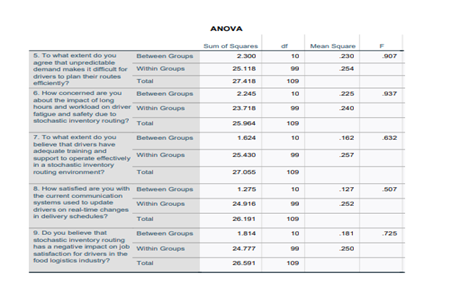
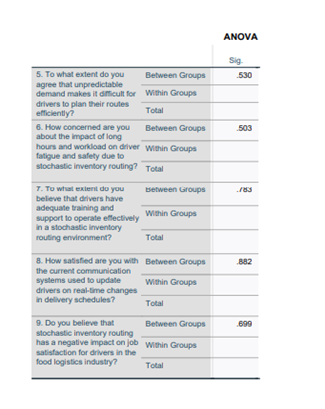
Figure 7: ANOVA
The One-Way ANOVA results presented in the analysis reveal varied levels of significance across different survey questions. For Questions 1 to 4, where significance levels are not provided, caution is advised in drawing definitive conclusions about the observed differences in responses. The absence of significance information limits the ability to confirm whether these differences are statistically significant or merely reflective of natural variability.
The one-sample T-Test, in a random order to different factors and they gave the industry place to get reliable insight into how a professional perceives things. The tests check the average ratings of candidates with a standard value. This observes their significant differences. The next section discusses the results of each question and it provides insight that how optimization of routes through logistic systems can be used to improve fuel efficiency along with promoting food safety.
There are typically loaded or empty trucks on the delivery route mean difference is significantly noted, as compared to a hypothetical value (t = 22.135, p < .001). Through the outcome's striking nature, can understand that a noteworthy and large-scale number of trucks are observed to work at a lower capacity than their original one. There will be some lacking and insufficiencies in the process through which these deliveries are to be made. This calls for a thorough observation of under delivery happens, how does it impact the overall productivity among others
The question at hand discusses that how improper planning of routes will contribute to excessive consumption. The rate given standing at 1.55. The fuel efficiency is affected largely by the route planning when significant difference is concluded against the norm of 0 with a strong consensus among people; (t = 32.404, p < .001). This quote shows that there should be strategies present to enhance the performance and reduce the cost.
The effectiveness of reducing energy waste in inventory is not as expected. This could be derived from the low mean rating of 1.56 by the participants. There is an overriding shared concern for the industry among all participants, as there is a significant difference from the hypothetical value. This highlights the need for enhancing and upgrading the strategies to be more aligned with the changing requirements of food supply chain landscape.
The results of the survey are highly significant, with users unanimously agreeing how unpredictable food demand leads to more spoiled stock. The 0 value is a hypothetical one, giving a baseline for how impactful the current system is on minimizing food wastage efforts. This result shows the strategies and need to safeguard food products to maintain market demands at different.
Green logistics can help the food industry to reduce waste. The rating of 2.45 is significantly different from the expected value (0), with t-value as 49.577 (p < .001). By results, it is evident that industries need to adopt and promote practices friendly for the environment among their workers. The implication here is clear: It has become clear that if are to sustain the low energy consumption and focus on a smaller environmental imprint, then sustainability needs to have the center stage.
If the implications of one sample t-test are to be summarized, notice that a particular pattern keeps reoccurring. The people who participate in surveys are agree on some points through the path of food delivery. They noticed it as a good chance and challenge.
There are certain pressing concerns that the industry professionals acknowledge, such as ineffective route planning, fluctuating demand and less productivity of trucks.
In order to improve the proficiency of inventory routing in logistics, need a different and big approach. They can work on the strategies so that can efficiently respond to demand changes, optimize the routes and in turn save fuel.
The importance of these challenges and sustainability imitative is necessary for the paving of a practical industry approach. Through the insights obtained, stakeholders can strategize interventions in a way that'd make the food supply ecosystem more resilient against environmental and other damages.
The results of this research serve as a strong tool that tells us the direction towards sustainable environmental paradigms. The advantages of using inventory routings are not limited to just their logistical benefits. It is a pivotal way through which can promote productive strategies and ensure sustainable practice within the larger collective vision for the future.
Through the outputs, one can understand how important drivers' experiences are to handle inventory. It showcases measures in which form challenges for accessed within survey questions Through Cohen's d and Hedges' correction, one can effectively evaluate the significance of changes in survey responses.
When observe partially loaded and empty trucks, the effect size is large according to both Cohen's d (1.335) and Hedge's correction (1.772). The surveyed results showed that different groups of people perceive the frequency of empty trucks differently.
Common patterns consist of three issues, one which deals with the naturally uncertain demand and the other related to route planning for delivery. There exists observable differences within the groups if see through the lens of effect sizes, which in turn highlight the real word importance of these variations.
The effect sizes are significant due to specifying spoilage and the importance of green logistics practices for question 14 and 15. According to me there are apparent differences in what kinds of food gets spoilt and how necessary people think green- related practices are.
This shows a higher level of precision and estimate of the population effects. This correction also provides us with a more accurate measurement of the effect size, because it tackles any biases within Cohen's "d". The survey response differences and their significance across various kinds of drivers' experiences can be consistently highlighted by using and values.
By increasing the need for focused interventional tactics, these findings provide valuable insights of how delivery drivers perceive their job. The findings will be more reliable and there are significant differences among the groups that were being tested if the precision of the effect size is increased.
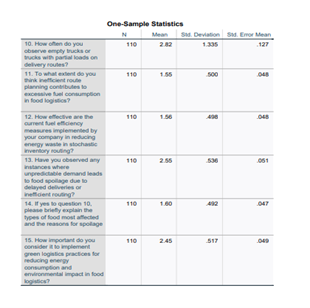
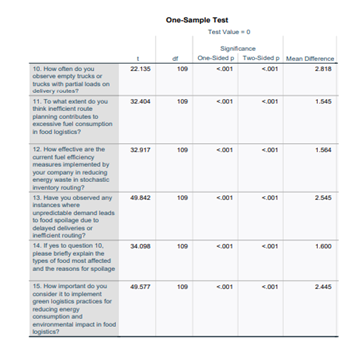

Table 2: One Sample Statistics
The One-Sample T-Tests conducted on responses to various questions in the stochastic inventory routing survey reveal highly significant results across all examined aspects of the logistics process. With p-values well below the conventional significance threshold of 0.05, the observed differences in mean ratings from the hypothetical value of 0 are statistically significant.
The use of the Multilayer Perceptron (MLP) model to predict the experience level of individuals in food logistics through the provided data is useful and can bring attention to problems. From the case processing summary, found out that out of all the cases received, only one case was not suitable for analysis. That means 109 cases were suitable for analysis. These 75 cases were set aside for training practice and the rest 34 cases were reserved for testing.
The summary of the model indicates that the cross-entropy error is a vital parameter used to measure the model's ability to accurately predict various events it observes. In the given model training, the cross-entropy error comes out to be 108.735 resulting in 70.7% incorrect predictions.
Significantly, the halting rule was activated after a single successive step without any reduction in error, and the duration of the training was minimal (0: 00:00.01). By looking at the sample test results, That the accuracy rate of the model was 61.8%, and the cross-entropy error was 49.386.
The classification tables give a comprehensive view of how the model predicts different categories of experience. The model appears to have a high level of accuracy, particularly in the "4-6 years" and "More than 10 years" categories, with a rate of 95.5% and 97.3% respectively in the train sample. to predict the "7-10 years" and "Less than 1 year" categories.
The test results are not accurate and need improvement, especially in identifying the "7-10 years" age category. The training samples had a higher accuracy rate of nearly 30%, while the testing samples had an even higher accuracy rate of 38.2%.
The research shows that the model has problems predicting certain experience types, suggesting that there may be complexities in the data that the model does not understand fully. Even though the model shows excellent results in certain areas, its low accuracy in other areas seems to raise questions about its applicability in a broad range of situations. This shows that the algorithm can be influenced by the training dataset, to be careful while using it for accurate predictions of long-term experience in food logistics.
Additional improvements can be made to enhance the model's forecast accuracy. This may include doing feature engineering to extract useful information from the dataset or adjusting the model parameters for better learning. Moreover, since the accuracy rate is very low, the model can be enhanced through more training cycles or by using a wider range of and diverse data. By implementing these measures, the effectiveness of the model in predicting the skills in the food logistics sector.
The model tries its best to predict years of experience in the field of food logistics, its results on the test sample show some limitations. The problems that were found highlight the importance of continually enhancing and verifying the model to ensure that it performs properly in actual-world settings. In order to gain maximum benefit from predictive analytics in food logistics, frequent modifications and be knowledgeable about the drawbacks of machine learning algorithms.
The significance of the Multilayer Perceptron (MLP) model in predicting years of experience in food logistics is nuanced based on the presented results. While the model exhibits strengths in certain experience categories, as evidenced by high accuracy rates for "4-6 years" and "More than 10 years," challenges are apparent in accurately predicting other categories, leading to lower overall accuracy.
The analysis of regression, food logistics survey is conducted. This analysis helps to determine the relationship between different. The model summary evaluates the performance of the regression model in a detailed way 10.6% of the variability to predict a certain kind of company can be collectively accounted for by the variables included in the analysis.
Even though multiple variables are being taken into account, the value of R Square is drastically low with a 0.006. It explains even if the large number of predictors are included, the model can't capture variation effectively.
The ANOVA results show the significance of the complete regression model. The calculated p-value 0.401 is greater than the given significance level of 0.05, we'll not reject the null hypothesis. This statement points out that the regression model is not able to significantly predict the company's type. The questions in this survey would focus either on billing, type of food products ordered or number and timings of the deliveries.
These will not highlight other important areas such as quality and safety norms between the suppliers and venders.The coefficients can provide what is the level of impact that a particular predictor has on the response variable.
The survey aims to ask the importance of reducing energy consumption during food logistics through green logistic strategies. The question 15 holds a strong and good impact because of 0.050 p-value significance. People who focus on environmentally friendly business methods are more likely to be within a certain category in the food logistics sector.
During the delivery process, how much does driver get accustomed and efficient to navigate routes in a random inventory driven many times do they face empty or partially loaded. The p-values of 0.057 and 0.248 in exhibit 7 are relatively low, which indicates that a statistical significance is very close to being met while the variables being referred to can help in predicting the company's kind, they are not adequate enough on a statistical level.
It is recommended to add a predictor question on how economy. An insignificant relationship is found between the types of firms through particular variables since their p-values are 0.090 and 0.208.
Certain predictors shown indirectly have their own particular importance on the business's features that tell us about company types in the food transportation industry. The survey is designed to cover several areas such as environment, operations, and staff satisfaction. The certain sign that these factors may be more influential and impactful than others is important to determine the kinds of companies.
They can get details of what defines the company type through regression analysis, A great strategy is needed to enhance the firm's quality (R square) and the efficiency within logistic operations to perform better. The model will validate and analyze the data more efficiently. It ensures a better understanding of how different companies work in the supply chain field, if additional analysis is done on it.
Table 3: Model summary

Table 4: Model Summary
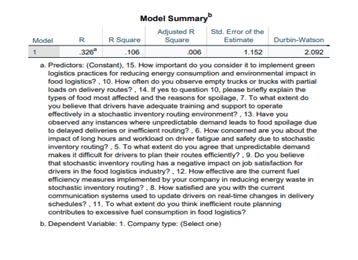
Table 5: ANOVA
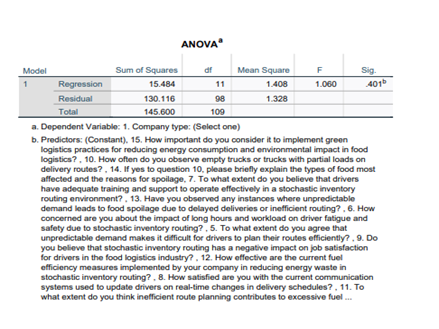
Table 6: Coefficients
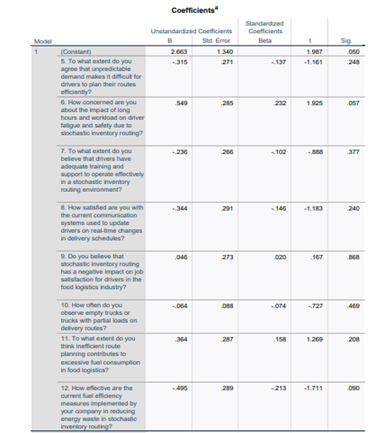
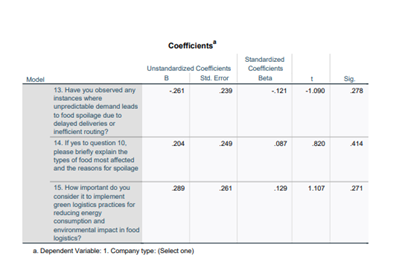

Table 7: Histogram
The regression analysis depicts that the concept is important and meaningful in its entirety. Even when the number of predictors is taken into consideration, the point to modify business types through this model can be restricted because only about 10.6% are accounted for by variance (R Square). The kind of company cannot be predicted by the regression model, this data is statistically not significant because the p-value= 0.401>0.05.
The research used the General Linear Model (GLM) to examine how the number of dependent variables is affected by "Years in food logistics" through a different multivariate approach. The Box's test is done with the intension of checking whether the covariance matrices and different. The assumption that the variances and covariances across groups is diminished, since the Box's M value is 75.873 and its p-value of 0.917 does not suggest significance. This model validates the given thesis in a very strategical way.
It performing transition for multivariate tests, the main focus is set on certian statistics including Pillai's Trace, Wilks' Lambda, Hotelling's Trace and Roy's largest root. There are multiple tests done for result. Survey shows that every level of experience has its own positive or negative influence on people as seen by statistical evidence an important point is that the effect sizes give distinct points of view.
The effect sizes present within the intercept and represented variables are crucial in providing a pathway towards understanding the practical significance of these associations. The magnitude of correlations through the linkages can be determined and it shows how important these experienced levels are in real world situations for the variables that depend.
The Levene test is one of the important factors that needs to be kept assessing there are similar variance across error terms between groups especially when dealing with dependent variables. The variance among the groups cannot be averagely controlled because the questions' p-values fall above 0.05. This leads us to the point that assuming similarity among groups is a valid assumption and this strengthens findings.
According to this data, it is clear that years spent working within food industry logistics isn't only some statistical value because of dependent variable. Such outcome is evident based on the research. The effect size will tell the level to which some relationships and behaviors give us can be considered important. A better understanding of complex concepts is very beneficial for stakeholders because it provides insight about the dynamic variables and customer preferences that they can cater to.
The results obtained from the General Linear Model (GLM) provide a deep exploration of relationships among important assumptions and their effect size. This shows that they not only prove the relationship statistically significant but delve deeper to gain more insights.
Despite different stimulating sub-environments, the complex environment provide a strong base for making important decisions. The research provides detail information of relations with and practical impacts of statistical data.
Table 8: Between subjects factors
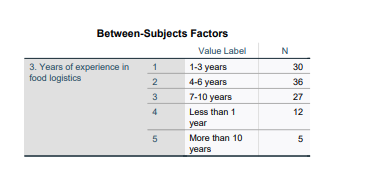
Table 9: Box text of Equality

Table 10: Multivariate Tests

Table 11: Levene’s test of equality of error variances
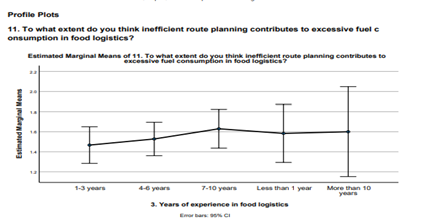
Figure 8: Profile Plots
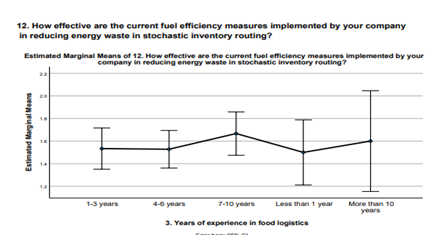
Figure 9: Years of experience in food logistics

Figure 10: estimated marginal means

Figure 11: years of food logistics
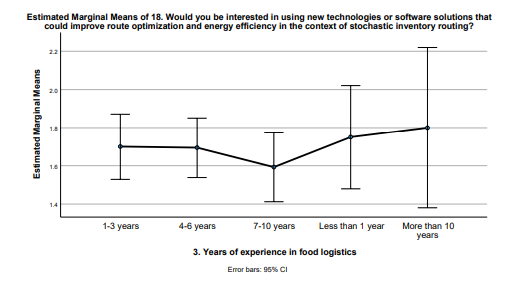
Figure 12: energy efficacy food logistics
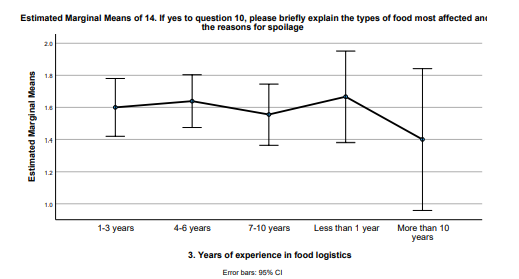
Figure 13: experience in food logistics
The GLM analysis was performed to examine the effect of years spent on food logistics for several responses. It has been noticed that the given factor holds importance (p<0.05). Testing the existence of dissimilar categories selected variances and co-variances being similar; Box concludes the dependability on the resulting research projects. Through significant connections, it is inferred that how diverse experiences contribute significantly towards the dependent variables.
It determined multiple areas of the supply chain business based on food items to dive into for a better understanding. They aim was to understand the underlying problems and intricacies belonging to the industry by beginning with some descriptive statistics. By looking at the data one can understand that how participants view and plan routes according to demand, make forecasts for services.
This will help companies offer efficient practices. The descriptive statistics primarily provide a summary of the data. This summary will helps researchers to dig deep further in their studies. The impact that multiple factors had on the answers from the recipients was to be recognized after One-Way ANOVA was put in place.
Multiple elements were looked upon. These consists of the intricacy in setting routes, tutors' preparedness, driver's fatigue and communication system among other aspects. The ANOVA revealed important insights that there are certain areas of improvement and concentration within the domain of food logistics.
The T-TEST helped us narrow focus down to specific questions. The questions that are asked from the participants were about the fuel efficiency and route planning, by which they want to quantify efficient categories. The result of T-test emphasizes that these issues are severe and need to be addressed specifically. This provides deeper insights into the importance of treatment plans.
The AI field is included by and extending the investigation, using multilayer perceptron analytical techniques. This method helps us to estimate some important patterns and links since these might be hard to immediately recognize. Studying the technology improvements via Multilayer Perceptron could lead to better optimization of energy in food logistics; this will result in a better understanding of the incoming data.
The regression model, were able to evaluate how the dependent variables get impacted by several independent factors, and this added value to research. The help of this analytical method, are able to know how different factors affected company. The two variables analysed were the need of implementing eco-friendly logistic approaches and how often are the freight vehicles observed to be empty.
Through regression analysis, we've been able to get valuable insights into complex processes that go on and learned to understand this in a timely manner. Finally, in the General Linear Model - MULTIVARIATE was able to fully capture the positive impact of 'Years of experience in food logistics" on models.
This was a major breakthrough in the food logistics field. Another important factor that needs to be kept in mind is the role of an individual's experience levels when it comes to forming perceptions and beliefs across a range of aspects within the field. This study can help us deeply understand the problems in food supply chain logistics and how they were analysed through multimodal analysis.
The way chose always defines what kind of challenges are going to face, changes how effectively and the opportunities that will come with it. These techniques include all types of strategies from sophisticated analysis to descriptive insights. This method allows students to debate and industry leaders to act. And also, offers a better way for food logistics operations.
The statistical analysis on different components of food supply chain management gave rise to numerous valuable recommendations. These proposals focus to boost the performance of industry, minimize the environmental effects and enhance efficiency. In order to mitigate fuel wastage, it is first important to zero in the issues hampering efficient routes.
The data collected through the responses indicates that there could be better fuel efficiency with the use of innovative technology within Question 18. In order to plan the routes, businesses need to invest in some technologies that do not follow any predefined route plans; rather, they make decisions on the go by using real-time data for adjusting trip durations caused by weather or traffic. It was noted in questions 5 and 17 that this will lead to minimized fuel consumption by making better stochastic routing choices.
Another important befit of using logistical techniques that are responsible environmentally is this cannot be over emphasized. It is important to highlight that using these two statistical methods get useful insights of what is happening in data. In order for businesses to elevate their social, environmental, and economic impact they need to make sustainability efforts a top priority. Initiatives should be taken which will help in reducing the impact on the environment and increase sustainable development by using less energy.
Although this idea was taken from Question 15, it is in line with the aims of global sustainability and spurs increased interest in environmentally conscious methods within the industry. Along with the factors previously mentioned, it is observed that driver related metrics play a crucial role in logistical efficiency. The drivers must be taken care of, since they are responsible for on the ground delivery schedules by effective modes of communication and given proper training. A better way to improve the security and efficiency of operations is by focusing on reducing driver fatigue and ensuring their satisfaction within the organization.
This will not only reduce the cost that is being spent on energy but also optimize the whole process. Businesses must be smart in their operations and collaborate with technology companies to update the logistics systems. This brings the companies to where they want themselves to be, allowing them to drive innovation and digitalize the business operations.
Moreover, it is pivotal to know that distinction of years of experience through the GLM, emphasize on the point that the employees should be experienced and trained in their respective domains. In any business need to create an environment where their employees can share ideas and communicate. So, the company needs to invest in activities helping team building.
This leads to boost industrial performance which is discussed in the previous question and this increase satisfaction at work that is a positive end result. The proposal provides a good strategy for resolving issues and tapping the opportunities in food logistics business. Businesses to handle workload challenges and develop an innovative work culture by making investments in technologies, emphasizing on environmental responsibility and human capital.
The researchers to make advancements and improvements in current methodologies, strategies and models as the subject offers a wide array of study materials. It future one way that must focus on is how to increase the efficiency of tracking the food chain. Temperature, humidity, and environmental conditions can be monitored at any given time if Internet of Things sensors are used in transport vehicles and warehouses. This ensures that the quality of food is and the safety is measures are maintained throughout.
Moreover, according to my opinion block chain technology can be very helpful to ensure a safe supply of chain.
A future research may plan strategies in a more cost-effective yet environmentally friendly way. Hence, this seeks to provide a beneficial approach for the academia practitioners and stakeholders to take into account for a sustainable impact another study aims for checking upgrade methods of distance parcel delivery to decrease fuel consumption by increasing the efficiency.
In order to meet global environmental targets, the industry stakeholders need to see if such practices are scalable and economically viable; there is a big benefit.
Multi-level perceptron analysis that has been done throughout this work expands the horizon to build predictive models for demand, route optimization, stating and energy by giving a tool through which can deeply dive into insights on how products are being used.
By adding artificial intelligence-based decision making support systems into logistics, businesses can improve their supply chain management because these systems are more efficient and adaptable to any change. Also, the combined effects of soci-economic issues and logistics performance can offer a lot when it comes to research opportunities.
If there are specific strategies to be developed for a food logistics system, need to understand how elements in the given region interact with each other and what they mean for logistics. To achieve this aim, there should be detailed and diversity sensitive case studies to decode all the people's voices involved in different financial situations.
It is important to analyse the impact of recent styles in order to see how they are changing global food habits. The rise in demand of plant derived products, e-commerce trend is also gaining popularity amongst food retail industry. People in the industry will know how to change their business strategies to meet changing consumer preferences if they investigate how these preferences impact distribution and the environment.
There is a lot of potential in the upcoming research for food logistics. These opportunities are related to new technology, environmental sustainability and changes within a local community.
Abideen, A.Z., Sundram, V.P.K., Pyeman, J., Othman, A.K. and Sorooshian, S. (2021). Food Supply Chain Transformation through Technology and Future Research Directions—A Systematic Review. Logistics, [online] 5(4), p.83. doi:https://doi.org/10.3390/logistics5040083.
Department for Environment Food & Rural Affairs (2021). United Kingdom Food Security Report 2021: Theme 3: Food Supply Chain Resilience. [online] GOV.UK. Available at: https://www.gov.uk/government/statistics/united-kingdom-food-security-report-2021/united-kingdom-food-security-report-2021-theme-3-food-supply-chain-resilience [Accessed 28 Nov. 2023].
Joshi, S., Sharma, M., Ekren, B.Y., Kazancoglu, Y., Luthra, S. and Prasad, M. (2023). Assessing Supply Chain Innovations for Building Resilient Food Supply Chains: An Emerging Economy Perspective. Sustainability, 15(6), p.4924. doi:https://doi.org/10.3390/su15064924.
Kaviyani-Charati, M., Ameli, M., Heidarzadeh Souraki, F. and Jabbarzadeh, A. (2022). Sustainable network design for a non-profit food bank supply chain with a heterogeneous fleet under uncertainty. Computers & Industrial Engineering, 171, p.108442. doi:https://doi.org/10.1016/j.cie.2022.108442.
Khan, S.A.R., Razzaq, A., Yu, Z., Shah, A., Sharif, A. and Janjua, L. (2021). Disruption in food supply chain and undernourishment challenges: An empirical study in the context of Asian countries. Socio-Economic Planning Sciences, p.101033. doi:https://doi.org/10.1016/j.seps.2021.101033.
Liu, L., Lee, L.S., Seow, H.-V. and Chen, C.Y. (2022). Logistics Center Location-Inventory-Routing Problem Optimization: A Systematic Review Using PRISMA Method. Sustainability, 14(23), p.15853. doi:https://doi.org/10.3390/su142315853.
Mirabelli, G. and Solina, V. (2022). Optimization strategies for the integrated management of perishable supply chains: A literature review. Journal of Industrial Engineering and Management, 15(1), p.58. doi:https://doi.org/10.3926/jiem.3603.
Rabbani, M., Navazi, F., Eskandari, N. and Farrokhi-Asl, H. (2020). A green transportation location-inventory-routing problem by dynamic regional pricing. Journal of Industrial Engineering and Management Studies, [online] 7(1), pp.35–58. doi:https://doi.org/10.22116/jiems.2020.110006.
Singh, S., Kumar, R., Panchal, R. and Tiwari, M.K. (2020). Impact of COVID-19 on logistics systems and disruptions in food supply chain. International Journal of Production Research, 59(7), pp.1–16.
Vilas-Boas, J.L., Rodrigues, J.J.P.C. and Alberti, A.M. (2022). Convergence of Distributed Ledger Technologies with Digital Twins, IoT, and AI for Fresh Food logistics: Challenges and Opportunities. Journal of Industrial Information Integration, 31, p.100393. doi:https://doi.org/10.1016/j.jii.2022.100393.
Bänsch, K., Busse, J., Meisel, F., Rieck, J., Scholz, S., Volling, T. and Wichmann, M.G., 2021. Energy-aware decision support models in production environments: A systematic literature review. Computers & Industrial Engineering, 159, p.107456.
Chandan, A., John, M. and Potdar, V., 2023. Achieving UN SDGs in Food Supply Chain Using Blockchain Technology. Sustainability, 15(3), p.2109.
David, D.U., Aikhuele, D.O., Ughehe, P.O. and Tamuno, E.M., 2022. Multi-echelon, Multi-period Supply Chain Master Planning in the Food Process Industry: A Sustainability Concept. Process Integration and Optimization for Sustainability, 6(2), pp.497-512.
Fadhel, A.W., 2021. Closed-Loop Sustainable Food Supply Chain Management: Design of Network Models for Efficient Operations (Doctoral dissertation, Northeastern University).
Ferraro, S., Cantini, A., Leoni, L. and De Carlo, F., 2023. Sustainable Logistics 4.0: A Study on Selecting the Best Technology for Internal Material Handling. Sustainability, 15(9), p.7067.
Gładysz, B., Buczacki, A. and Haskins, C., 2020. Lean management approach to reduce waste in HoReCa food services. Resources, 9(12), p.144.
Godde, C.M., Mason-D’Croz, D., Mayberry, D.E., Thornton, P.K. and Herrero, M., 2021. Impacts of climate change on the livestock food supply chain; a review of the evidence. Global food security, 28, p.100488.
Hasnan, N.Z.N., Yusoff, Y.M., Lim, S.A.H. and Kamarudin, K., 2023, November. Potential of industrial internet of things (IIoT) to improve inefficiencies in food manufacturing. In AIP Conference Proceedings (Vol. 2907, No. 1). AIP Publishing.
Jazinaninejad, M., Nematollahi, M., Zamenjani, A.S. and Tajbakhsh, A., 2022. Sustainable operations, managerial decisions, and quantitative analytics of biomass supply chains: A systematic literature review. Journal of Cleaner Production, p.133889.
Joshi, S., Sharma, M., Ekren, B.Y., Kazancoglu, Y., Luthra, S. and Prasad, M., 2023. Assessing Supply Chain Innovations for Building Resilient Food Supply Chains: An Emerging Economy Perspective. Sustainability, 15(6), p.4924.
Kaviyani-Charati, M., Ameli, M., Souraki, F.H. and Jabbarzadeh, A., 2022. Sustainable network design for a non-profit food bank supply chain with a heterogeneous fleet under uncertainty. Computers & Industrial Engineering, 171, p.108442.
Kler, R., Elkady, G., Rane, K., Singh, A., Hossain, M.S., Malhotra, D., Ray, S. and Bhatia, K.K., 2022. Machine learning and artificial intelligence in the food industry: a sustainable approach. Journal of Food Quality, 2022, pp.1-9.
Kumar, A. and Agrawal, S., 2023. Challenges and opportunities for agri-fresh food supply chain management in India. Computers and Electronics in Agriculture, 212, p.108161.
Kumar, U. and Shankar, R., 2022. Application of Value Stream Mapping for Lean Operation: An Indian Case Study of a Dairy Firm. Global Business Review, p.09721509221113002.
Laktena, J., 2023. Balancing Demand and Supply Planning in the Food Supply Chain: Insights from a Dairy Industry Case Study.
Liu, L., Lee, L.S., Seow, H.V. and Chen, C.Y., 2022. Logistics Center Location-InventoryRouting Problem Optimization: A Systematic Review Using PRISMA Method. Sustainability, 14(23), p.15853.
Mancini, S., 2022. Advantages of integrating crowdshipping into Reverse Logistics (Doctoral dissertation, Alpen-Adria-Universität Klagenfurt).
Mangla, S.K., Börühan, G., Ersoy, P., Kazancoglu, Y. and Song, M., 2021. Impact of information hiding on circular food supply chains in business-to-business context. Journal of Business Research, 135, pp.1-18.
Mirabelli, G. and Solina, V., 2022. Optimization strategies for the integrated management of perishable supply chains: A literature review. Journal of Industrial Engineering and Management (JIEM), 15(1), pp.58-91.
Raa, B. and Aouam, T., 2022. Buffering variability in stochastic cyclic inventory routing. In EURO2022.
Rabbani, M., Navazi, F., Eskandari, N. and Farrokhi-Asl, H., 2020. A green transportation location-inventory-routing problem by dynamic regional pricing. Journal of Industrial Engineering and Management Studies, 7(1), pp.35-58.
Rivera, A.F., Smith, N.R. and Ruiz, A., 2023. A systematic literature review of food banks’ supply chain operations with a focus on optimization models. Journal of Humanitarian Logistics and Supply Chain Management, 13(1), pp.10-25.
Sharma, S., Gahlawat, V.K., Rahul, K., Mor, R.S. and Malik, M., 2021. Sustainable innovations in the food industry through artificial intelligence and big data analytics. Logistics, 5(4), p.66.
Singh, S., Kumar, R., Panchal, R. and Tiwari, M.K., 2021. Impact of COVID-19 on logistics systems and disruptions in food supply chain. International journal of production research, 59(7), pp.1993-2008.
Sîrbu, A., 2023. Sustainability Approach of the Baking Industry Along the Food Supply Chain. In Baking Business Sustainability Through Life Cycle Management (pp. 53-77). Cham: Springer International Publishing.
Taghikhah, F., Voinov, A. and Shukla, N., 2019. Extending the supply chain to address sustainability. Journal of cleaner production, 229, pp.652-666.
Tripathi, V., Chattopadhyaya, S., Mukhopadhyay, A.K., Sharma, S., Singh, J., Pimenov, D.Y. and Giasin, K., 2021. An innovative agile model of smart lean–green approach for sustainability enhancement in Industry 4.0. Journal of Open Innovation: Technology, Market, and Complexity, 7(4), p.215.
Vilas-Boas, J.L., Rodrigues, J.J. and Alberti, A.M., 2023. Convergence of Distributed Ledger Technologies with Digital Twins, IoT, and AI for fresh food logistics: Challenges and opportunities. Journal of Industrial Information Integration, 31, p.100393.
https://www.statista.com Sculpture dioxide (SO2) emissions from waste collection, treatment and disposal services in the United Kingdom (UK) from 1990 to 2017 /statistics/480681/sulphur-dioxide-emissions-of-waste-collection-and-treatment-uk/
Are you confident that you will achieve the grade? Our best Expert will help you improve your grade
Order Now










